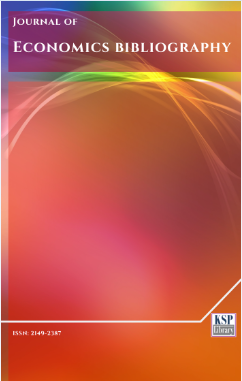Effective Cost of Borrowing from Microfinance Institutions
Abstract
Abstract. It has been observed lately that the dependence on moneylenders for borrowing needs of poor borrowers remained stable despite the presence of MFIs, particularly in developing economies. This is surprising given the fact that MFIs charge relatively lower interest rate as compared to moneylenders. The paper explains this trend by arguing that the effective cost of borrowing from MFI is higher relative to the effective cost of borrowing from moneylender. It is due to the additional burden incurred in the form of transaction costs in case of MFI borrowing. Simulation results also support this phenomenon.
Keywords. Microfinance, Group lending, Informal finance, Transaction cost, Effective cost.
JEL. G21, O16, O17.
Keywords
References
Aghion, B.A. (1999). On the design of a credit agreement with peer monitoring, Journal of Development Economics, 60(1), 79-104. doi. 10.1016/S0304-3878(99)00037-1
Aghion, B.A., & Gollier, C. (2000). Peer group formation in an adverse selection model, The Economic Journal, 110(465): 632-643. doi. 10.1111/1468-0297.00557
Ahmed, Z.A. (1989). Effective cost of rural loans in Bangladesh, World Development, 17(3), 357-363. doi. 10.1016/0305-750X(89)90209-X
Banerjee, A.V., & Duflo, E. (2010). Giving credit where it is due, Journal of Economic Perspectives, 24(3), 61-80. doi. 10.1257/jep.24.3.61
Besley, T., & Coate, S. (1995). Group lending, repayment incentives and social collateral, Journal of Development Economics, 46(1), 1-18. doi. 10.1016/0304-3878(94)00045-E
Bhatt, N., & Tang, S.Y. (2001). Designing group-based microfinance programs: Some theoretical and policy considerations, International Journal of Public Administration, 24(10), 1103-1125. doi. 10.1081/PAD-100105104
Bhatt, N., & Tang, S.Y. (1998). The problem of transaction costs in group-based micro lending: An institutional perspective, World Development, 26(4), 623-637. doi. 10.1016/S0305-750X(98)00007-2
Chung, I. (1995). Market choice and effective demand for credit: Roles of borrower transaction costs and rationing constraint, Journal of Economic Development, 20(2), 23-44.
Dehem,T., & Hudon, M. (2013). Microfinance from the clients’ perspective: An empirical enquiry into transaction costs in urban and rural India, Oxford Development Studies, 41(1), S117-S132. doi. 10.1080/13600818.2013.787057
Field, E., & Pande, R. (2008). Repayment frequency and default in microfinance: Evidence from India, Journal of the European Economic Association, 6(2-3), 501-509. doi. 10.1162/JEEA.2008.6.2-3.501
Ghatak, M. (1999). Group lending, local information and peer selection, Journal of Development Economics, 60(1), 27-50. doi. 10.1016/S0304-3878(99)00035-8
Goto, H. (2012). Repayment Frequency and Repayment Performance in Microfinance, WIAS Discussion paper, No. 2012-002: WIAS
Jain, S. (1999). Symbiosis vs. crowding-out: The interaction of formal and informal credit markets in developing countries, Journal of Development Economics, 59(2), 419-444. doi. 10.1016/S0304-3878(99)00019-X
Jain, S., & Mansuri, G. (2003). A little at a time: The use of regularly scheduled repayments in microfinance programs, Journal of Development Economics, 72(1), 253-279. doi. 10.1016/S0304-3878(03)00076-2
Karduck, S., & Seibel, H.D. (2004). Transaction costs of self-help groups: A study of NABARD’s SHG banking programme in India, [accessed October 10, 2015].
Laureti, C. (2012). Flexibility and payment discipline in microfinance, Manuscript, Belgium: Université de Mons and UniversitéLibre de Bruxelles.
Pal, S. (2002). Household sectoral choice and effective demand for rural credit in India, Applied Economics, 34(14), 1743-1755. doi. 10.1080/00036840210121228
Pradhan, N.C. (2013). Persistence of informal credit in rural India: Evidence from ‘All-India Debt and Investment Survey’ and beyond, Working paper, WPS(DEPR)- 05/2013: RBI
Reed, L. R. (2011)‘State of the Microcredit Summit Campaign Report 2011’, Microcredit Summit Campaign, Washington, DC. Quoted in Goto, H. (2012). Repayment Frequency and Repayment Performance in Microfinance, WIAS Discussion paper, No. 2012-002: WIAS
Rojas, M., and Rojas, L.A. (1997). Transaction costs in Mexico’s preferential credit, Development Policy Review 15: 23-46.
Seenivasan, R. (2015). High interest rates are an amorality in microfinance, Economic and Political Weekly 3,75-77.
Shankar, S (2007). Transaction costs in group microcredit in India’, Management Decision, 45(8), 1331-1342. doi. 10.1108/00251740710819069
Stiglitz, J.E. (1990). Peer monitoring and credit markets, The World Bank Economic Review, 4(3), 351-366.
DOI: http://dx.doi.org/10.1453/jeb.v3i1.674
Refbacks
- There are currently no refbacks.
.......................................................................................................................................................................................................................................................................................................................................
Journal of Economics Bibliography - J. Econ. Bib. - JEB - www.kspjournals.org
ISSN: 2149-2387.
Editor: [email protected] Secretarial: [email protected] Istanbul - Turkey.
Copyright © KSP Library

